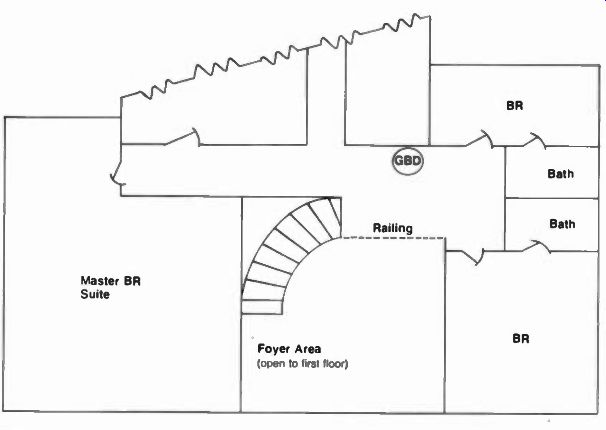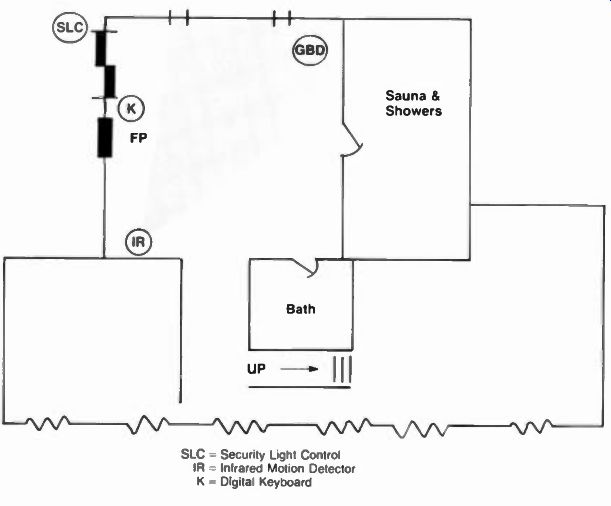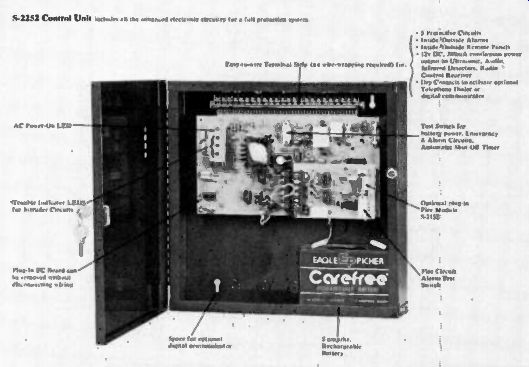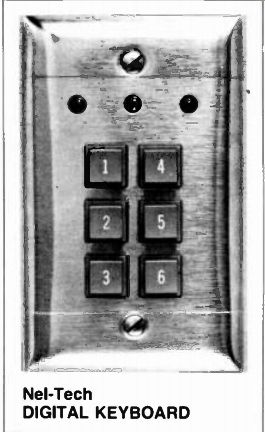In the first part of this two part article on residential security system design we began to lay out a system and specify the components of it. Here we complete our design and tie up the loose ends.
by James A. Ross* and Steven Browne**
* Capital Security and Surveillance Systems, Inc., Washington, D.C.
** Solid State Electronics, Rockville, MD.

Fig. 1. First floor plan. Shaded area indicates coverage by IR motion detector.
There is more to the security business than the technical design of security systems. Both the legal liability and the technical design aspects of residential security are covered in this article.
Legal Liability
In response to the first article in this series Mr. P. Bernard Fritz of Fritz Radio and TV Service in Reading, Pennsylvania wrote: "I am very pleased to see the starting of your series on security electronics ... As with most shops facing a declining service volume, I am looking for ways to diversify my operation. I have considered adding the sale, installation, and service of security equipment to my business.
The one thing that has deterred me from going ahead is the possibility of lawsuits where burglars have managed to defeat the system which was installed. I would appreciate if you would address this particular situation and advise how one might avoid litigation, should a successful burglary occur, after a proper installation has been made ... " First, let us say "thanks" for writing and for bringing to our attention this subject of liability-which certainly must be a prime consideration of anyone who is thinking of entering the security business.
There are three things which you should do to limit your liability in the security business:
1) Only work when the job is defined by a written contract,
2) Carry adequate liability insurance, and
3) Establish a reputation for quality.
Written Contract
Your lawyer will advise you regarding the advisability of incorporating, state and local licenses required, etc.; and you should seek his help in creating a simple, straightforward contract for use in connection with all commercial and residential security systems. This contract will specifically state that your liability is limited, and will describe the limit. This is your principal defense and should be carefully done.
Even with the written contract, you should be careful in what you or your salesman say while trying to make the sale. Your lawyer can advise you on the legal perils involved in oral claims, and how they could be used in litigation; but you should also be wary of what can happen to you outside of court. If a consumer complains to a consumer-action group, you'll find that you'll have to spend an inordinate amount of time defending yourself, instead of working in your business.
These administrative procedures can be extremely expensive because of the time that you must spend to defend yourself.
Liability Insurance
Just as your lawyer should be used in his area of expertise, your insurance man should be consulted to establish the necessary insurance protection.
There is at least one firm which advertises liability protection for burglar and fire alarm companies.
Bayly, Martin & Fay, Inc. of San Antonio, Texas. Your insurance company may know of others.
Premiums will be set based on several factors, but liability insurance is a must.
Quality Reputation
Regardless of all other considerations your first and last line of defense is to do a good system design, use quality hardware, install it properly and service it promptly and well. Talk to people in the business; they'll tell you which equipment is good and which equipment is bad. Inform yourself about the shady competition which promises a lot for a very low price. If you understand what they do, you can protect yourself from the temptation of using shortcuts in order to try to bring your price down to their level. You are better off to refuse to bid on any job that you cannot truly take pride in.
Quality work is your first line of defense, because the systems you install will perform as intended; and, therefore, will not be defeated by a burglar.

Fig. 2. Partial second floor plan showing location of the glass break detector
(GBD) which protects the front door.

Fig. 3. Partial basement floor plan. Shaded area indicates coverage by IR
motion detector. (Basement walls without windows are below ground.)

Fig. 4. Nutone S-2252 Control Panel.
Nel-Tech DIGITAL KEYBOARD

Fig. 5. Nel-Tech Digital Keyboard.
Quality work is your last line of defense because it creates a reputation for quality. If a system should fail and you end up defending yourself in court, your good reputation might be the factor which will cause the decision to be made in your favor.
Technical Design
In part 1 of this two-part article on the subject of design of a residential security system we established the goal of the system and special considerations this way, "... most protection with the least inconvenience to family and servants." We also defined portions of the system as follows:
1) Nutone S-2252 Panel
2) Colorado Electro Optics Security Light controls at three doors. (These are not connected into the control panel.)
3) Perimeter circuit with recessed plunger switches on all exterior doors connected to N/C terminals. Floor mat at front door connected to N/O terminals. Glass break detectors "look" at all windows not otherwise protected, and are connected to the fast response perimeter terminals.
Glass break detectors also protect the sliding glass doors. Alarm screens are used on all windows which can be opened, and are connected into the N/C normal response perimeter circuit.
4) Fire and smoke detectors are connected into the fire/smoke circuit.
5) Passive infrared motion detectors cover the first floor entrances and the basement entrance, and are connected to the interior circuit.
Always remembering "KISS" (see article in June issue) and keeping in mind that your reputation for quality work starts with good system design, we proceed with our theoretical design for maximum security with minimum inconvenience.
Control Circuits
Figure 1, Figure 2 and Figure 3 show the layout of the house-first floor, second floor, and basement respectively with the location and coverage of the motion detectors and the location of the glass break detectors and digital keyboards. Note that only two of the doors are considered exit-entry doors and that these two have digital keyboards located on the interior wall next to the door. In connection with these exit entry doors, it is extremely important to be sure that the coverage patterns of the passive infrared motion detectors do not prevent access to the digital keyboards for a person entering the house.
Digital Keyboards
These are located inside the protected premises because there is no real reason for them to be outside, and if they are outside they are subjected to weather and vandals. Also, consider the possibility that the burglar accosts you as you return home. If the keyboard is outside and visible, he knows that you must deactivate the system before entering. If, however, the keyboard is inside, you have options that you would not have with an outside keyboard. First, you can ignore it, and the alarm will sound after the preset entry delay time.
Second, you could press several keys simultaneously, thereby creating an instant alarm. This "panic" feature cannot be used on outside keyboards because any passerby could cause an alarm at any time-an intolerable situation.
The digital keyboards allow you to turn perimeter and/or exterior circuits "off" or "on" without having to go to the control panel. Status lights on the keyboard provide the information on which circuits are "on," and also indicate alarm status. Circuits are activated (or deactivated) by punching in a simple code which can be easily changed if you suspect that it has been compromised. If an error has been made in entering the code, a different, reset, code must be entered before the system will accept any further commands. This feature means that if someone tried to guess your code and made an error, the number of variables is increased -- making his guessing job even more difficult.
Signaling
So far we have designed a system to detect fire or intrusion. The next step is to provide a signaling system which will call for help and perhaps scare the intruder into running away. Local alarms, such as interior or exterior lights, bells, horns, or sirens are used for these purposes. If there is sufficient noise, your neighbors-if they are at home--may telephone the police. Also, light and noise might frighten the intruder enough to cause him to leave. After all, he knows he's breaking the law and he doesn't know who can hear the alarm, nor how the alerted individual(s) will react.
Far more likely to result in decisive action, however, is remote signaling- frequently called "silent alarm". Every good fire/intrusion system should provide this feature because of the uncertainty of response to a local alarm. The most common method of signaling is through a telephone dialer which can be either a tape dialer or a digital dialer. The tape machine will dial a series of telephone numbers--friends, associates, neighbors--and play a recorded message such as "This is John Doe. My house at 1234 First Street has just been broken into." More modern, and much to be preferred, is a digital dialer which dials a central station and transmits a digitally coded message. Yes, monitoring by a central station does cost the homeowner more. He must pay a monthly charge for the service, but he knows that an alarm will be heard and that the proper authorities will be notified. Central stations are manned 24 hours per day, seven days per week. In any large city you'll have a choice of several local monitoring services. Also, there are several national services which maintain "800" telephone numbers so they can be dialed from anywhere without toll charges.
For this design we are going to use a horn on each level inside the house and an exterior bell fastened as high as possible on the rear of the house.
We'll use the 3M monitoring service for our central station and a digital dialer with different coded messages for fire and intrusion.
Other Sensors
There are many other sensors available which we have chosen not to use for various reasons. First and foremost among these reasons is the fact that the more complex the system, the more false alarms and breakdowns. Also, remember that the family must be able to live with the system and use it. If it is too complicated, there is a temptation to turn it off and not use it. Our perimeter circuit provides very good security without the mess (and expense) of taped glass. We have backed up the door plunger switch at the front door with a N/O mat switch. (Remember, the exit-entry doors and this mat switch must be connected to the exit entry delay circuit.) Ultrasonic and microwave motion detectors have not been used for two reasons. First, they are more prone to false alarms than the passive infrared motion detectors. Second, they do not have a sharp sensing pattern, tending instead to be very broad. That means that, if they were used, they would have to be connected into an interior delay circuit so that a person could enter and reach the digital keyboard without causing an alarm. We prefer to use the sharp-patterned infrared sensor aimed in such a way that the keyboard can be approached upon entering, but motion in other areas will cause an instant alarm.
In this regard let's consider a design goal that could be very important: the intruder should be repelled before he enters the house or as soon as possible after he enters. We do not want a weapon-carrying burglar to be well into the house before the horns and bell sound because we do not want him to feel that he is trapped and has to shoot his way out.
Operation
If our potential burglar approached any of the doors after dark, the security light control will turn on the outside lights and this alone will probably cause him to change his mind. We have not connected these controls into the alarm system because we would then create an alarm for every approach after dark--friends, delivery men, and even the homeowner himself.
The fire circuit in this design cannot be turned "off," and we recommend that the perimeter circuit be left "on" except during periods of heavy in and out traffic.
The panel, of course, is equipped with a battery and charger, so that it will operate even if normal power is lost. (Figure 4).
When the family leaves the house, the digital keyboard by the door is used to activate the interior circuit.
The alarm does not sound because the motion detector is aimed away from the keyboard and exit door. Also, the user must "tell" the system that he is leaving so that it will not alarm when he opens the door.
When he returns, the homeowner unlocks his door, tells the system that he has returned, and disarms the interior circuit--all through the digital keyboard next to the door. (Figure 5)
Before the advent of remote control through digital keyboards, the location of the control panel was critical because of the need to get to it to prevent an alarm after entering. In this design, with two remote keyboards, the panel location is not as critical. It will be somewhere on the second floor so the family can activate the interior circuit (motion detectors in basement and on first floor) when they retire for the night.
Summary
The fire/intrusion alarm system which has been described in these two articles is representative of a good security system for a residence. The objective was the simplest possible design which affords a high degree of protection with a minimum of down time and false alarms. We've tried to present the reasoning behind all of our design decisions, and, as always, your questions and comments are welcome.
(source: Electronic Technician/Dealer)
Also see: Residential Security System Design, Part 1--Basic Principles